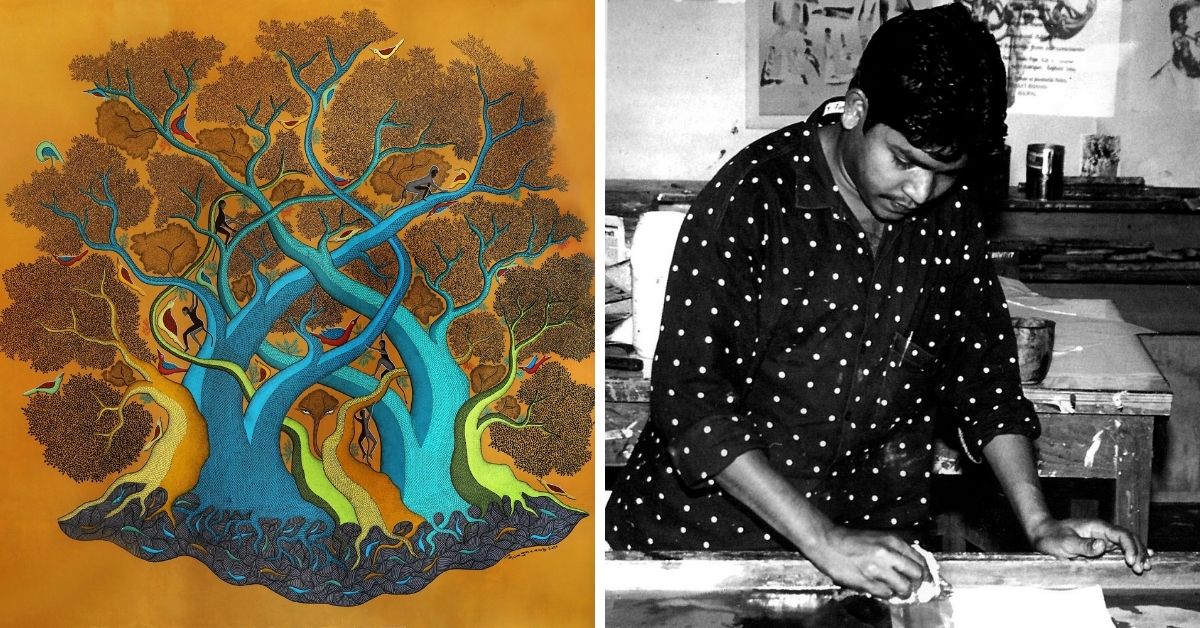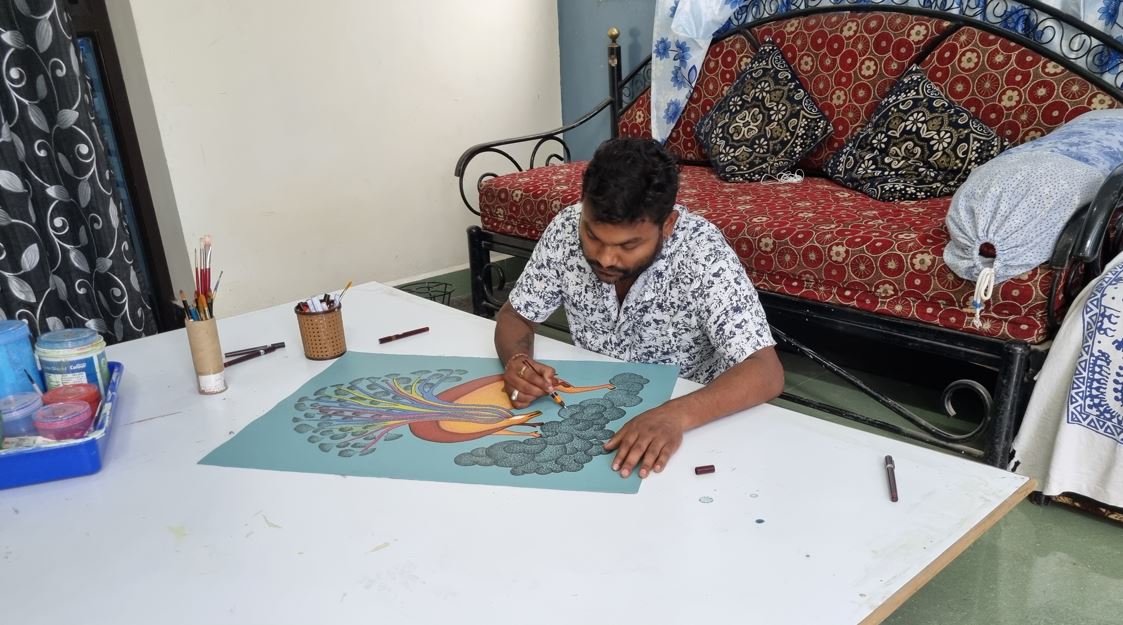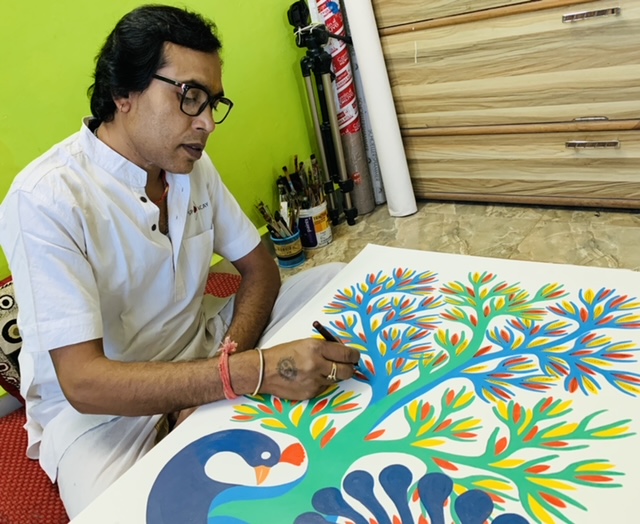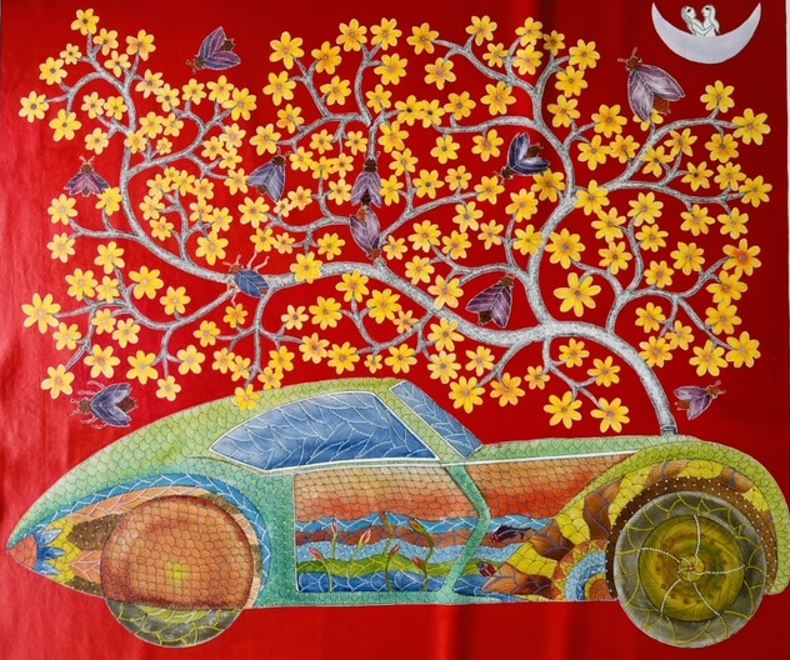The Man Who Took Gond Art From Tribal Huts to The World’s Top Museums
Gond artist Jangarh Singh Shyam went from drawing on the walls of tribal huts to his art being displayed in prestigious museums. Today, his legacy is carried forward by his family.

An image of Lord Hanuman was drawn with lime and charcoal by hand on the humble red mud walls of a small hut in the remote village, Patangarh, of Dindori district of Madhya Pradesh in 1981. The artist was 17-year-old Gond Pradhan boy Jangarh Singh Shyam. The simplicity, the clean lines and the innocence of the figure helped catapult the hitherto confined Gond tribal art and the artist onto the national and international art circuit.
That was the year when the government of Madhya Pradesh planned to build a multi-purpose art centre, Bharat Bhavan, in its capital city Bhopal. Contemporary and well-known artist Jagdish Swaminathan was given the responsibility of establishing the centre where both urban and rural (folk and tribal) arts could be displayed. While scouring the villages of MP for tribal art, he saw the drawing of Lord Hanuman on the walls of a tribal home. That’s when he discovered the uninfluenced talent of Jangarh Shyam and brought him to Bhopal with the promise of work in the field he loved.
Thus began the saga of Gond art coming out of villages to the mainstream.
Swaminathan took it upon himself to introduce the young Jangarh to canvas and acrylic paints. The rest as they say is history. Without losing touch with his tribal roots or focus, the highly gifted boy soon learnt the new medium. His work, from being displayed on the walls of tribal huts, buffalo backs or kuccha roads, received a new stage in the galleries of Japan, the UK, Germany, France and the USA.
Unknowingly Jangarh became the pioneer of modern-day Gond art and paved the way for others from his village to find a new source of livelihood.

“My father was so passionate about drawing that he would draw with whatever he could get on buffalo backs when he took them out to graze in the forest of our village. The striking white lines on the black buffalo was much appreciated by the villagers,” recalls 35-year-old, Bhopal-based Mayank Singh Shyam, talking about his late father Jangarh. Barely 13 at the time of his father’s death, today Mayank along with his mother Nankusia Bai and sister Japani, are continuing the legacy of Jangarh Kalam, school of Gond art.
Explaining the tribal tradition of naming the child on some event happening around the birthday, Mayank says, “Our father was based in Japan when she was born and so she was named Japani. It was a full moon day when I was born and so I was named Mayank, which means the moon.”
Japani laughingly admits that as a child she hated her name as in the school it amused everyone and classmates used to pull her leg a lot. Even today many are bewildered at her name. But now she is happy with the uniqueness of it.
“Since childhood, we would sit next to our father and observe his style of work, techniques to wield paintbrushes and selection of particular brushes to use for different strokes. He would ask us to paint whatever we wanted on any piece of paper we could lay our hands-on,” remembers 32-year-old Japani, whose works are exhibited all over the world.
Though she hasn’t yet travelled abroad, she still gets queries and visitors from France, Germany and Japan to her home in Bhopal to either buy her work or to discuss Gond art.
One of Mayank’s works was even auctioned by Sotheby’s in the Indian Contemporary Art auction at New York, organised for the benefit of the Kolkata Museum of Modern Art. The first Gond art auctioned way back in 1988 was of course that of the torchbearer Jangarh Shyam.
Back then it had fetched $ 31,250, which was a large amount for tribal art.

Both the siblings have developed their style of painting though there certainly is a shadow of their father’s imagery in their work. Mayank uses a completely white background to paint with black whereas Japani uses white paint to draw on black background. Like many Gond artists, they too paint flora, fauna but with a story behind each of their figures.
The history of Gond art can be traced to the 14th or 15th century when the first Gond kingdom was traced to the central hilly regions of India. Today, the Gond tribals mainly reside in Madhya Pradesh and small pockets of its neighbouring states of Maharashtra, Andhra Pradesh, Telangana, Odisha and Bihar.
Like other tribals and Adivasis (Warli, Bhil, Saura etc.), even Gonds decorate their homes especially the outer walls and the courtyards of their huts with drawings using charcoal, vegetable and mineral dyes, coloured mud, etc. Flora and fauna from the main figures.
The word Gond is derived from the Dravidian word ‘kond’ which means green mountains. They have a story about every tree or animal they paint. For example, Sembar tree (Ceiba pentandra) is the abode of Gods and Holy spirits; the Mahua tree (Madhuca longifolia)—is used to make medicine, soft drink and liquor from the flowers of this tree. And the belief is that depending on how one consumes this drink the person gets transferred into a mouse or a tiger, pig or a pigeon! There are many other stories for different plants and animals, which have been narrated over generations by oral historians, known as Pradhan, who sing and narrate these stories to the accompaniment of a three-string instrument, the Bana.
“My father was a Pradhan singer and even today when I want to paint something based on our life, I go back to my village, listen to these songs and come up with an idea to paint a series of drawings,’’ explains Mayank.

Today, when we think of Gond art, it is only the Jangarh school of art. Every known artist who has moved from his village to the mainstream is courtesy of the late artist. Many of them have an international market for their work. Some of them have been awarded State and National awards including Padma Shri awarded to Bhajju Shyam. Each of them has added their individual touch to their work without losing their roots.
Artist Venkat Raman Singh Shyam, winner of Rajya Hasta Shilpa Puraskar of Madhya Pradesh, too was brought to Bhopal by his uncle Jangarh and asked to paint whatever he wanted. “Trees and animals play an important role in our lives and also in our work. But I wanted to do something different and my uncle encouraged me to do it saying not to become his clone and find my own identity as an artist,” he says.
So, keeping the Gond style of painting which uses carefully drawn lines to convey a sense of movement in still images and adding dots and dashes in different colours to get the form, Venkat Shyam, selects newsy subjects. When Mumbai was attacked in 2008, he painted ‘Smoking Taj’ (2009) showing the attack on the Taj Mahal Palace Hotel of Mumbai.
Lately, he has been painting a series on the pandemic, the lockdown effect and the sufferings of migrant labourers. Sometimes he talks about government apathy through his work.

One of the highest glory for Gond art was the success of Bhajju Shyam’s illustrated book The London Jungle Book in 2004. The Padma Shri recipient was also awarded Bologona Children’s Book Fair in 2008 for another book titled The Life of Trees Night.
Though there are many success stories, Gond artists still struggle, which was evident during the lockdown period. At a folk and tribal art exhibition recently, held after two years of the pandemic in Mumbai, there was a lot of footfall but there were very few buyers.
However, Gond artists are happy at the recognition their work is getting at the international level, even though they feel sad that their work doesn’t get the type of domestic recognition and buyers like other modern artists do.
If Jangarh Shyam Singh was alive today, he would have been the happiest man to see his proteges and his established Jangarh Kalam or school of art succeed so well.

Sources:
Sothebys
Down To Earth
Nature
(Edited by Yoshita Rao; Feature image source: link)
If you found our stories insightful, informative, or even just enjoyable, we invite you to consider making a voluntary payment to support the work we do at The Better India. Your contribution helps us continue producing quality content that educates, inspires, and drives positive change.
Choose one of the payment options below for your contribution-
By paying for the stories you value, you directly contribute to sustaining our efforts focused on making a difference in the world. Together, let’s ensure that impactful stories continue to be told and shared, enriching lives and communities alike.
Thank you for your support. Here are some frequently asked questions you might find helpful to know why you are contributing?


This story made me
-
97
-
121
-
89
-
167











